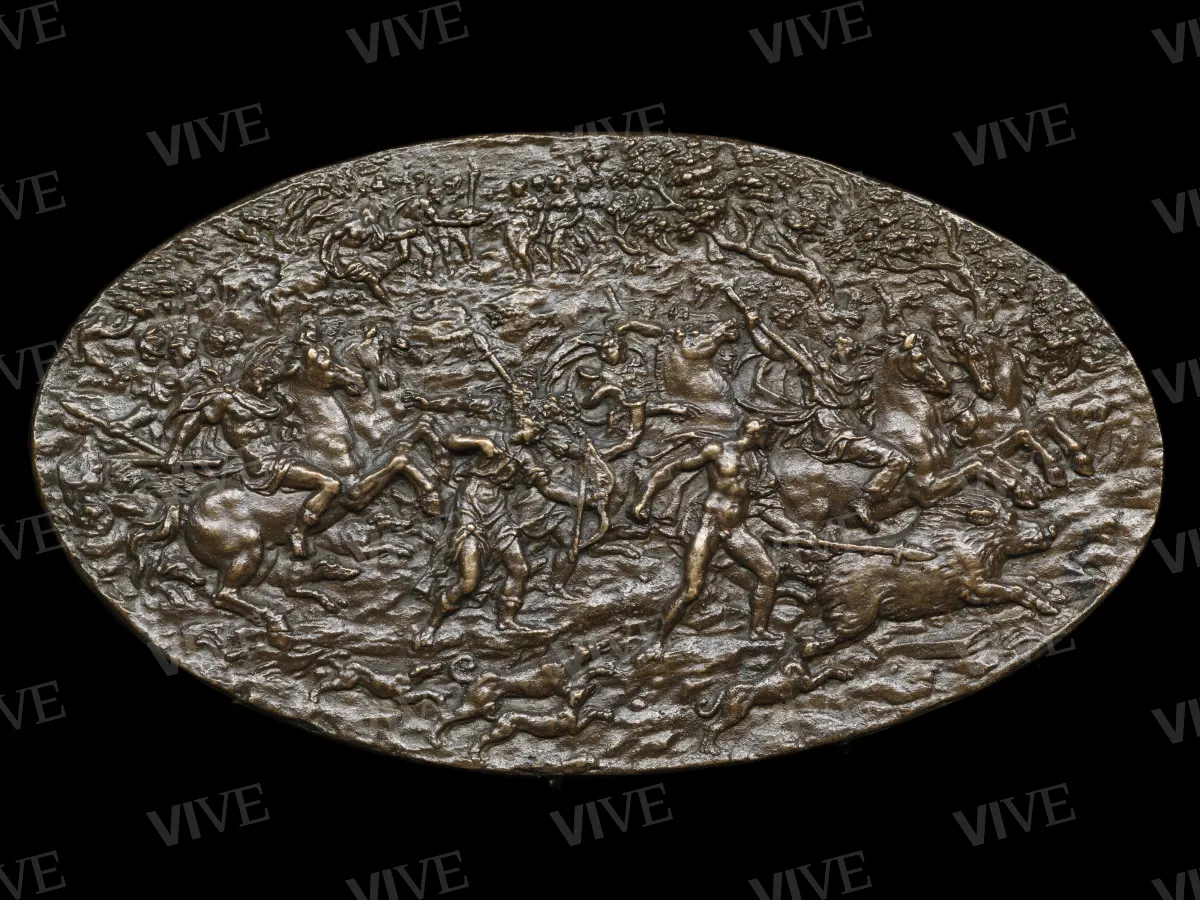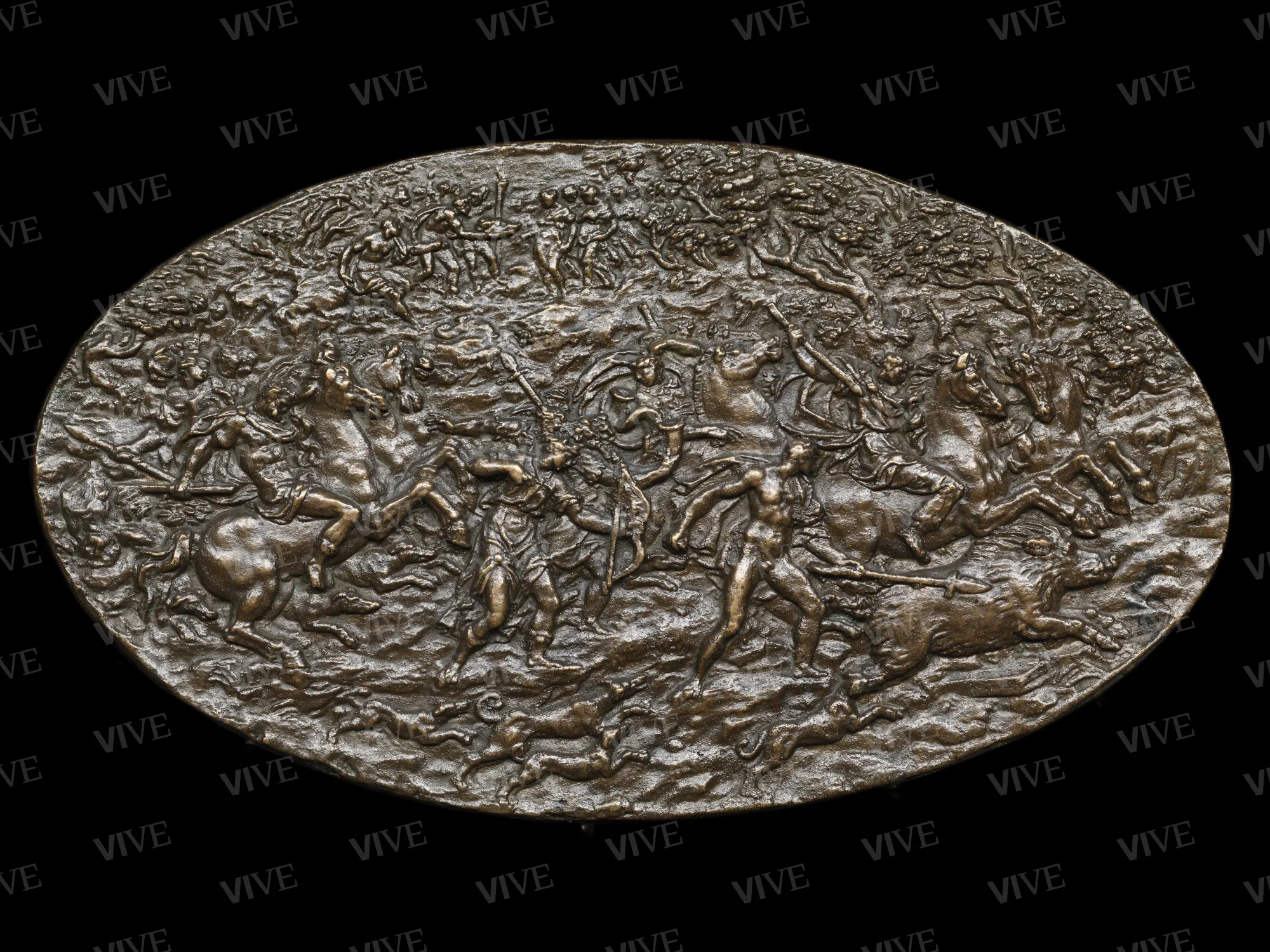The Hunt of Meleager and Atalanta
Guglielmo Della Porta C. 1555–1565
The plaque is one of sixteen mythological reliefs created by Guglielmo Della Porta in the latter half of the sixteenth century, intended to decorate furniture such as a cabinet or an inlaid table. The subject is the slaying by a contingent of Greek heroes of a boar dispatched by Diana to devastate Calydon. This hunting scene enables the artist to showcase animals, horsemen, and soldiers in an elaborate procession surrounding Atalanta, who has wounded the boar with an arrow, and Meleager, who administers the fatal blow using a javelin.
The plaque is one of sixteen mythological reliefs created by Guglielmo Della Porta in the latter half of the sixteenth century, intended to decorate furniture such as a cabinet or an inlaid table. The subject is the slaying by a contingent of Greek heroes of a boar dispatched by Diana to devastate Calydon. This hunting scene enables the artist to showcase animals, horsemen, and soldiers in an elaborate procession surrounding Atalanta, who has wounded the boar with an arrow, and Meleager, who administers the fatal blow using a javelin.
Details of work
Catalog entry
For identification of the mythological cycle comprising sixteen reliefs, including the plaque in question, refer to the entry for Dance of the Nymphs (inv. 10836). This scene draws inspiration from Ovid’s Metamorphoses (2022, Book X, lines 561–707), illustrating the hunt for the boar dispatched by Diana to devastate the region of Calydon in Aetolia as retribution against King Oeneus for neglecting to perform a sacrifice in her honor. Leading the hunt is the king’s son, Meleager, accompanied by notable heroes such as Castor and Pollux, Jason, Theseus, Pirius, and young Atalanta. Atalanta delivers the initial wound to the creature with an arrow, while Meleager readies his javelin to deliver the fatal blow. In the background, Atalanta is portrayed receiving the boar’s head as a trophy, an act which precipitates a tragic conflict between Meleager and his uncles, Plessippus and Tosseus.
Guglielmo Della Porta (c. 1510–1577) demonstrates a preference for varying poses and attributes, spatial density, and multiple lines of force, similar to the Dance of the Nymphs. Meleager is depicted naked and statuesque, potentially referencing an ancient group portraying the same figure, originally identified in the sixteenth century (Haskell, Penny 1981, 263; Doni 1549 [1970], 51v). Atalanta’s pose is elegant and languid, contrasting sharply with her counterpart, and she is clad in a transparent tunic. The horses are illustrated from different angles with precise anatomical detail, reflecting Della Porta’s comprehensive understanding of equine anatomy and his ambition in the mid-sixteenth century to create a monumental equestrian statue of Charles V (Extermann 2012, 64–67). By incorporating a centrifugal movement towards the boar and a circular movement around the two heroes, Della Porta departs from the frieze arrangement commonly used by Raphael and his direct or later followers, such as Giulio Romano, Francesco Salviati, and Giorgio Vasari. Instead, he creates a dynamic and varied composition that may be influenced by Michelangelo’s late frescoes (Last Judgment, The Calling of Saint Paul, and The Crucifixion of Saint Peter). Perino del Vaga, Della Porta’s mentor, also integrated Michelangelo’s stylistic innovations when depicting the same theme of the Calydonian boar hunt for a rock crystal intended for the Farnese casket, with a circular arrangement of the protagonists around the beast (Agosti 2019, 81). The quality of the modeling and the similarity to the Vienna example (Kunsthistorisches Museum, inv. KK. 7758) indicate a possible attribution to Della Porta.
Grégoire Extermann
Entry published on 12 June 2025
State of conservation
Good.
Restorations and analyses
No restoration is known.
Inscriptions
Back of the plaque painted in white at the top on the central axis: “P.V. 10837.”
Provenance
Vienna, Collezione Giacinto Auriti, 1922–1933;
Rome, Museo Nazionale di Palazzo Venezia, 1964.
Exhibition history
Rome, Museo Nazionale di Palazzo Venezia, Rilievi e placchette dal XVI al XVIII secolo, February 1–April 30, 1982.
References
Planiscig Leo, La collezione Auriti. Piccoli bronzi, placchette, incisioni e oggtti d’uso [1931], Roma 1964, p. 40, tav. LVII;
Doni Anton Francesco, Disegno. Facsimile della edizione del 1549 di Venezia, Milano 1970;
Haskell Francis, Penny Nicholas, Taste and the Antique. The Lure of Classical Sculpture 1500-1900, London 1981;
Cannata, in Casanova Maria Letizia, Cannata Pietro (a cura di), Rilievi e placchette dal XVI al XVIII secolo, catalogo della mostra (Roma, Museo Nazionale di Palazzo Venezia, 1 febbraio-30 aprile 1982), Roma 1982, pp. 72-76, n. 71;
Zanuso, in Di Lorenzo Andrea, Frangi Francesco (a cura di), Raccolta Mario Scaglia, Dipinti e sculture, medaglie e placchette da Pisanello a Ceruti, catalogo della mostra (Milano, Museo Poldi Pezzoli, 30 ottobre 2007-30 marzo 2008), Cinisello Balsamo 2007, p. 228;
Rossi Francesco, La collezione Mario Scaglia, Bergamo 2011, p. 354;
Extermann Grégoire, Il ciclo della passione di Cristo di Guglielmo della Porta, in Cupperi Walter, Extermann Grégoire, Ioele Giovanna (a cura di), La scultura del secondo Cinquecento a Roma, Roma 2012, pp. 59-112;
Agosti Barbara, Perino del Vaga e lo stile farnesiano, in Marongiu Marcella (a cura di), Michelangelo e la "maniera di figure piccole", Firenze 2019, pp. 75-82;
Publio Ovidio Nasone, Le metamorfosi, Paduano Guido (a cura di), con testo latino a fronte, Torino 2022.












